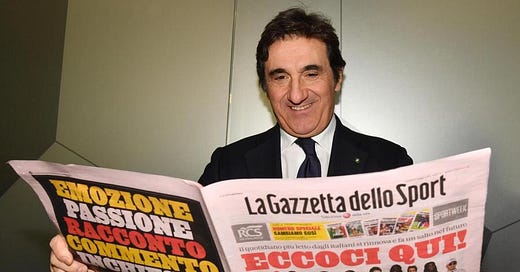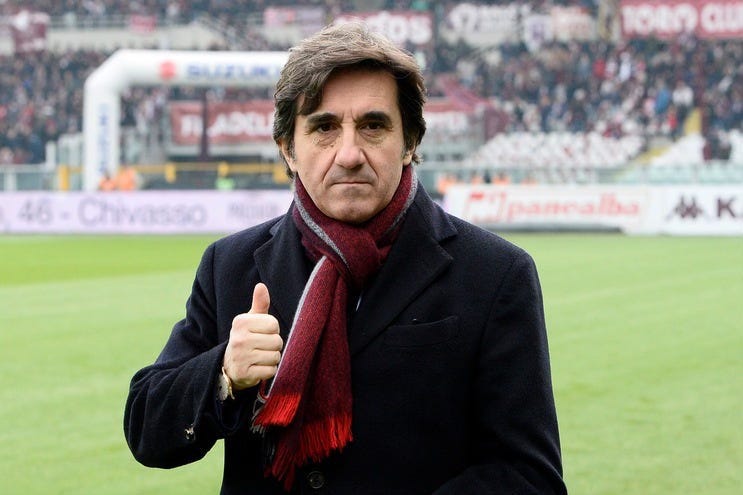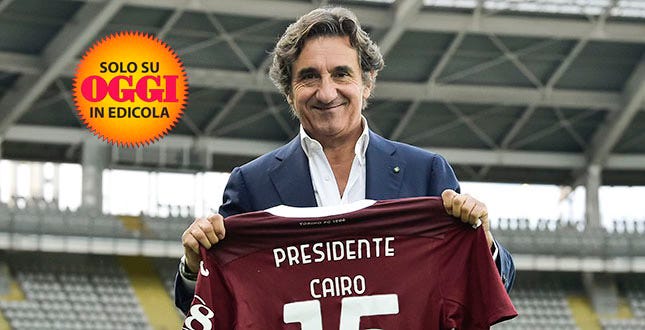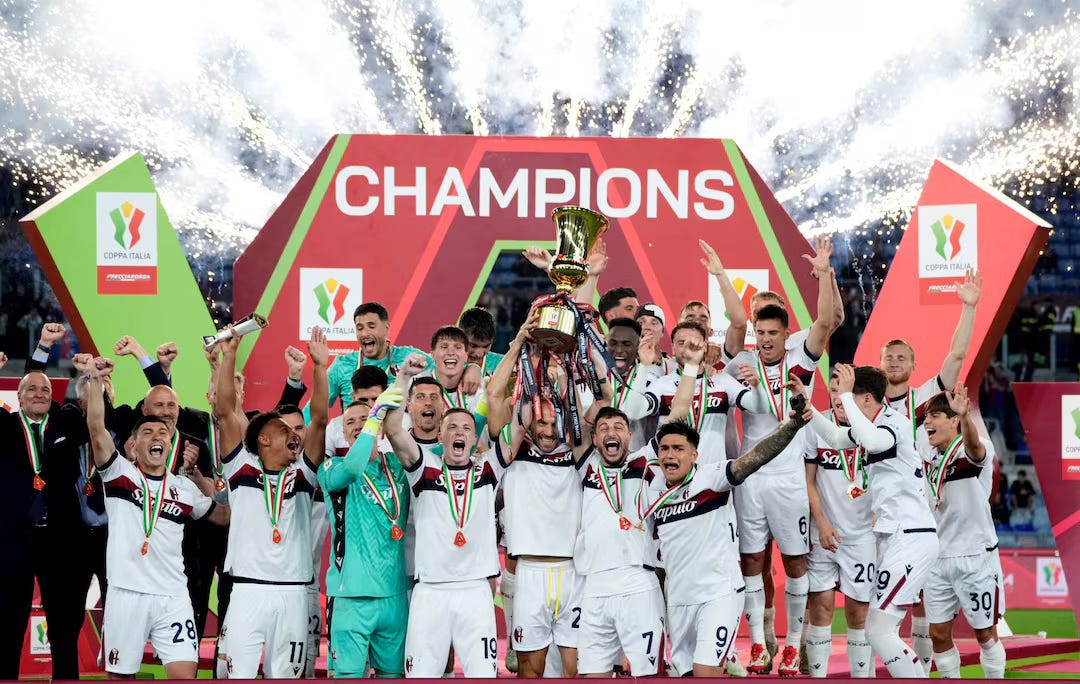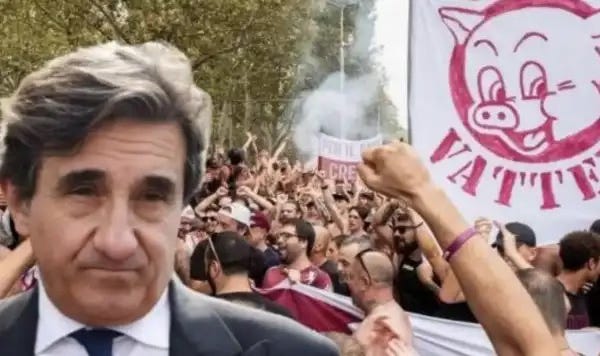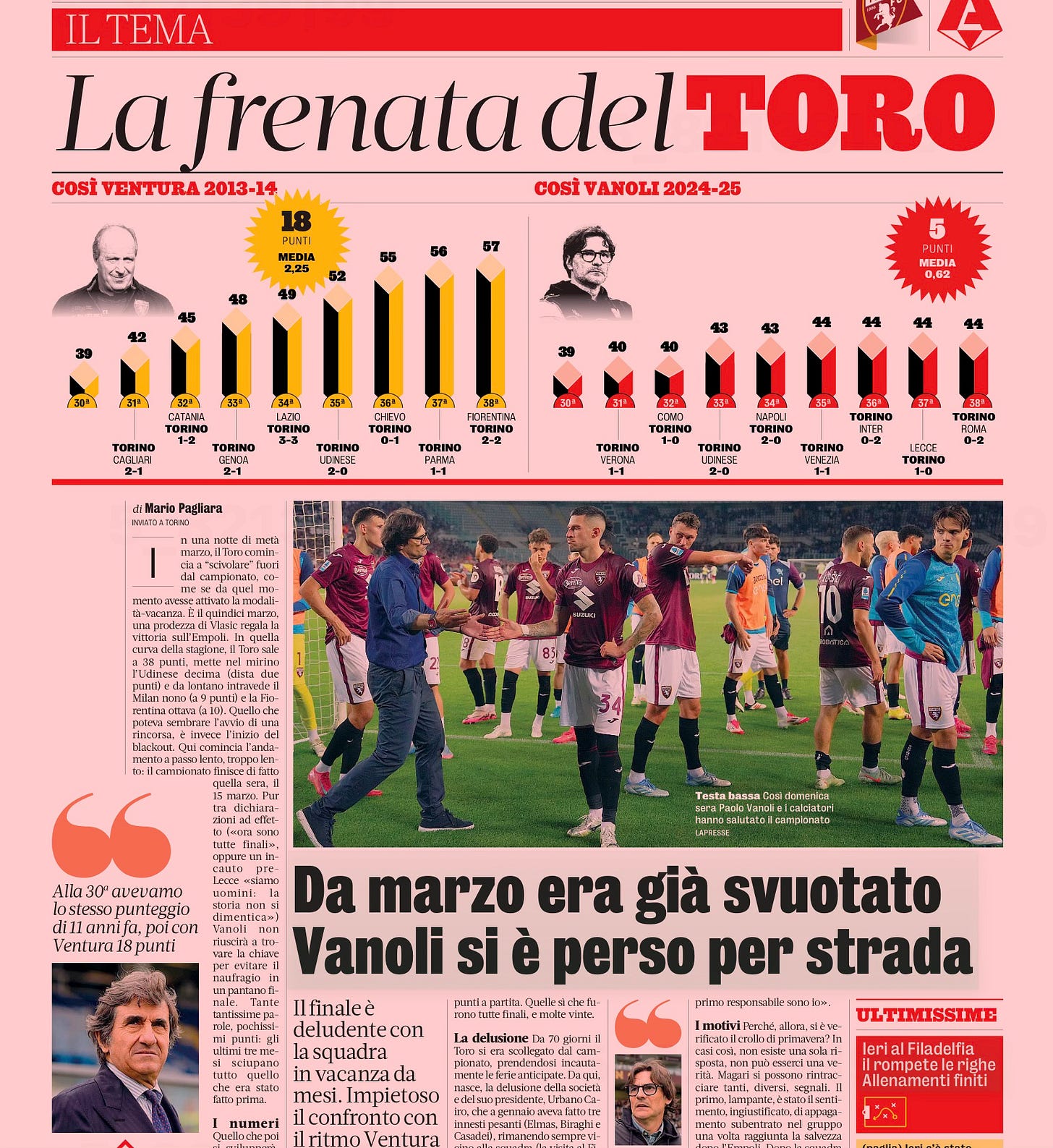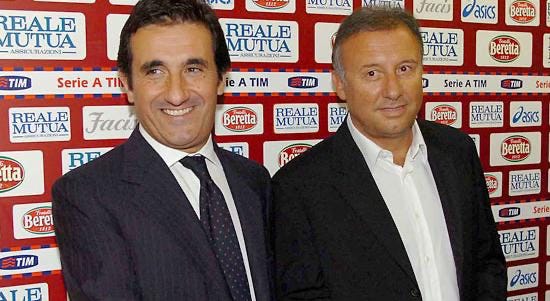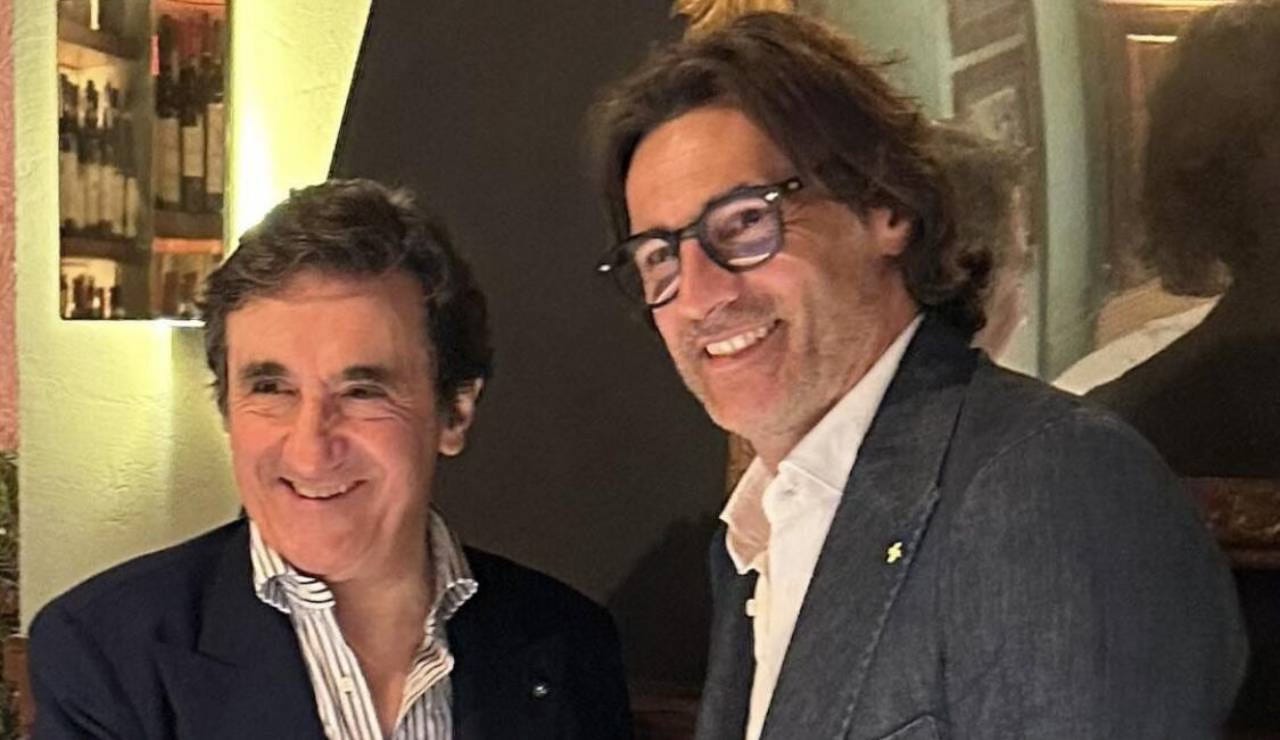The endless shame of Cairo’s Torino: another disgraceful season, a poor coach thrown to the wolves, and the club’s history and fans’ passion trampled once again
Cairo has been in charge for 19 seasons: the same as De Laurentiis, who led Napoli to two championships. Torino, on the other hand, due to its owner’s stinginess, has sunk into a black hole
(Translated into English by Grok)
Iezzo; Grava, Maldonado, Romito, Giubilato; Capparella, Amodio, Montervino, Bogliacino; Calaiò (Pià), Sosa.
Question: What team is this? Unless you’re a fan, or rather a superfan, of the club in question, answering is tough. But I’ll put you out of your misery: this is the typical lineup of the Napoli team that, acquired by Aurelio De Laurentiis and coached by Reja, earned promotion from Serie C to Serie B. The year, or rather the season, was 2005-06, the same season Urbano Cairo became the owner and president of Torino Calcio. The only difference: De Laurentiis started with Napoli in Serie C, while Cairo started with Torino in Serie B. And in 2005-06, Torino immediately reached Serie A, while De Laurentiis, as mentioned, climbed to Serie B. He would catch up to Cairo in Serie A the following year.
You might wonder: why this strange throwback that takes us back twenty years? And why compare two great entrepreneurs who, at a certain point in their lives, decided to step into the fray and become owners and presidents of two storied football clubs? The answer is simple: as La Settimana Enigmistica would say in its iconic “Sharpen Your Eyesight” column (“These two images differ in 20 small details. Can you spot them?”), I’ll now show you two seemingly similar portraits of two great clubs laden with championships, led for two decades by two great entrepreneurs who acquired them almost simultaneously, and then I’ll ask you to tell me what differences you see. After that, I’ll add a few personal reflections.
DE LAURENTIIS. In 2005-06, De Laurentiis’ Napoli was in Serie C. They won the league, earned promotion to Serie B, and then to Serie A, where they began playing in the 2007-08 season. Over 18 seasons, the club won 6 trophies: 2 championships, 3 Coppa Italia titles, and 1 Italian Supercup. By their third season (2009-10), they qualified for European competitions (the UEFA Cup, as it was then called) for the first time and have since consistently reached Europe—except for 2023-24—qualifying 6 times for the Europa League and 10 times for the Champions League.
CAIRO. In 2005-06, Cairo’s Torino was in Serie B. They finished third and were promoted to Serie A, starting to play there in the 2006-07 season, a year before Napoli. Over 19 seasons, the club has won no trophies; they were relegated to Serie B once, where they stayed for 3 years; and they have never qualified for European competitions. Or rather: it happens twice, but by default, due to disqualifications that first eliminate Parma (2013-14) and then Milan (2019-20). On the second occasion, Mazzarri’s Torino doesn’t even make it through after the reprieve, eliminated in the qualifying playoff by Wolverhampton.
Question: What differences did you notice between these two portraits that seemed similar at first glance? Did you perhaps spot any detail suggesting that Napoli’s president and owner, Aurelio De Laurentiis, has been slightly—perhaps imperceptibly—more skilled, adept, and inspired than Torino’s president and owner, Urbano Cairo? If you need more time to think, take it. But don’t forget: their starting points were the same (in fact, Cairo reached Serie A a year earlier), both clubs had a rich history and prestigious legacy (especially Torino, with 7 championships compared to Napoli’s 2), and the challenge between the two entrepreneurs and their respective clubs was, as they say, a level playing field.
You might say: well, it’s obvious there’s no comparison, but perhaps Napoli overperformed, as the experts say nowadays. Maybe De Laurentiis was just too good, also capitalizing on the immense passion of the Neapolitan fanbase. Kudos to De Laurentiis, not a failure on Cairo’s part. And you might be right.
So let’s see how other Italian clubs, less decorated than Napoli, have fared compared to Cairo’s Torino. Take Atalanta, for example, with zero championships in their history. While Torino spent 19 years winning nothing, never reaching Europe, and failing to give their fans any joy, Atalanta won a Europa League title. In the last nine seasons, they qualified for Europe 8 times—3 in the Europa League and 5 in the Champions League. Their Europa League triumph came after defeating Sporting Lisbon in the round of 16, Liverpool in the quarter-finals, Marseille in the semi-finals, and Bayer Leverkusen in the final. In 2019-20, they came agonizingly close to the Champions League semi-finals, losing in the final minutes to a PSG side featuring Neymar, Mbappé, Cavani, Thiago Silva, and Di Maria.
Or take Lazio. While Torino went 19 years without winning anything, without reaching Europe, or giving their fans a thrill, Lazio, with 2 championships in their history, won 6 trophies: 3 Coppa Italia titles and 3 Italian Supercups. In the last 19 seasons, they qualified for Europe 15 times: 3 in the Champions League, 11 in the Europa League, and 1 in the Conference League.
Or Roma. While Torino went 19 years without winning anything, without reaching Europe, or giving their fans a shiver of excitement, Roma, with 3 championships in their history, won 4 trophies: 2 Coppa Italia titles, 1 Italian Supercup, and 1 Conference League. In the last 19 seasons, they qualified for Europe 17 times: 8 in the Champions League, 8 in the Europa League, and 1 in the Conference League (which they won). In 2017-18, they reached the Champions League semi-finals, only to be eliminated by Liverpool (2-5, 4-2).
Or Bologna. While Torino went 19 years without winning anything, without reaching Europe, or giving their fans a spark of emotion, Bologna, with 7 championships in their history (like Torino, though all from the distant past except for their “most recent” in 1963-64), returned to the Champions League last year after a 60-year absence and won the Coppa Italia this year, beating Milan in the final. In 2008-09, they qualified for the then-UEFA Cup.
I could go on, but I think this is enough. If you’ve followed me this far, put yourself in the shoes of a Torino fan—yes, Torino, still remembered as one of the greatest and most legendary teams ever to grace the earth, the Grande Torino lost on May 4, 1949, in the Superga tragedy—and ask yourself: why did I have to end up with Urbano Cairo? A president-owner who, for twenty years, has run the club like a penny-pinching accountant, terrified of losing money, oblivious to the legacy of an immortal legend like Torino, which this year finished 11th, last year 9th, and before that 10th, 10th again, 17th, 16th, and so on in the most utterly disheartening mediocrity. A president-owner who, I’m not saying should win a championship 50 years after the last one by Pulici and Graziani (1975-76), but who could at least take us on a European adventure now and then, notice the existence of a talented sporting director like Sartori, hire a capable coach like Gasperini, spend a few million on a promising young talent like Barella or Tonali, win a derby against Juventus every three years or so, dust off the trophy cabinet with a new cup—any cup, even a minor one—and remind the world that Torino still exists.
But no. Nineteen years have passed, and Urbano Cairo has not only turned the Toro into a dairy cow everyone knows they can feast on, not only held the club hostage in the most disheartening mediocrity, not only shown no sign of freeing it and returning it to the passion of its millions of fans: but, having become a publisher and owner of newspapers like La Gazzetta dello Sport, he’s taken to using them like Mussolini’s propaganda machine to sing his own praises and, in the case of setbacks and disasters—which have been raining down on fans’ heads for twenty years—to construct a scapegoat, plaster them on the front page, and hold them up for public scorn as the sole culprit of the ongoing debacle. The latest in line: Paolo Vanoli.
What La Gazzetta dello Sport is doing these days, in the wake of yet another dismal season by Torino, is unbelievable (I was about to write: unconscionable). With a stomach-churning audacity that deserves a Guinness World Record, the crucifixion (or pillory, take your pick) of poor coach Paolo Vanoli has begun. Vanoli, whose best players were sold out from under him at the start of the season without so much as a heads-up, was sacked the day after Torino’s final match, a 0-2 loss to Roma, and branded as the sole culprit of the tragicomic season that ended in 11th place (as if that were news). The crucifixion began on Monday and continued on Tuesday, when Cairo’s newspaper claimed that when Vlasic scored the winning goal against Empoli on March 15, “Torino climbed to 38 points, set their sights on 10th-placed Udinese, and could faintly see 9th-placed Milan in the distance (…). What seemed like the start of a surge was instead the beginning of a blackout.” And what, according to La Gazzetta, was this blackout? Being 11th with 8 games left and finishing the season 11th.
Not content, on Wednesday, May 28—yesterday—La Gazzetta dedicated an entire page, the one daily devoted to Torino, to a statistic so perverse it’s an understatement to call it that. In an attempt to prove how deplorable Vanoli’s work was in the final stretch of the season, ruining Urbano Cairo’s “masterpiece” (!), La Gazzetta compared him to the final stretches of Ventura, Mazzarri, Juric, and Mihajlovic to highlight the coach’s inadequate performance. “Vanoli exits Serie A with the worst record in the final eight games,” La Gazzetta declares, as if a statistic based on 8 arbitrarily chosen games could have even the remotest significance.
Too bad the newspaper forgot to mention that, in the Cairo era, nine Torino coaches were sacked mid-season by the autocratic Urbano and thus can’t be included in the statistic—coaches Cairo must have deemed worse and more damaging than Vanoli, or else he would have let them finish the season, as he did with Vanoli. For those curious, in 19 years as Torino’s president, Cairo has sacked 10 coaches for a total of 14 dismissals (no joke: some were sacked multiple times): Stringara, De Biasi (three times), Zaccheroni, Novellino (twice), Colantuono, Beretta, Lerda (twice), Papadopulo, Mihajlovic, and Giampaolo. That said, I’m not sure whether I feel more disdain for Urbano Cairo the president or Urbano Cairo the publisher.
But back to the point, namely the 2005-06 Napoli lineup I opened this article with, the one De Laurentiis started his football adventure with. The point, as you’ve likely gathered, is that you can start with Capparella and Amodio and end up with Kvaratskhelia and Osimhen; you can start with Bogliacino and Sosa and end up with McTominay and Lukaku. You just have to want it. And be capable of it. Meanwhile, some start with Nicola and Rosina and end up with Pedersen and Borna Sosa. Though, come to think of it, Nicola and Rosina were probably better.
This, ladies and gentlemen, is Urbano Cairo. The owner and president of Torino, the most glorious club in Italian football, turned under his stewardship into a sideshow freak, a circus monster: “Step right up, ladies and gentlemen, don’t be afraid—the monster may look scary, but it won’t harm you!” If there were an Oscar in football for the Worst Calamity to Befall a Club, Urbano Cairo would deserve two statuettes: one for Worst Calamity of 2024-25 and one for his career. By acclamation.
P.S. If you enjoyed this article and think you’d be unlikely to read something like it in so-called traditional media, check out my “Palla Avvelenata” account and consider subscribing. For €6 (monthly subscription) or €60 (annual subscription), you’d read pieces like this every day and support my work, as hundreds of true sports fans, tired of being deceived by the courtiers of the establishment, are already doing in this mission of free, honest, and irreverent journalism toward those who deserve no deference.

